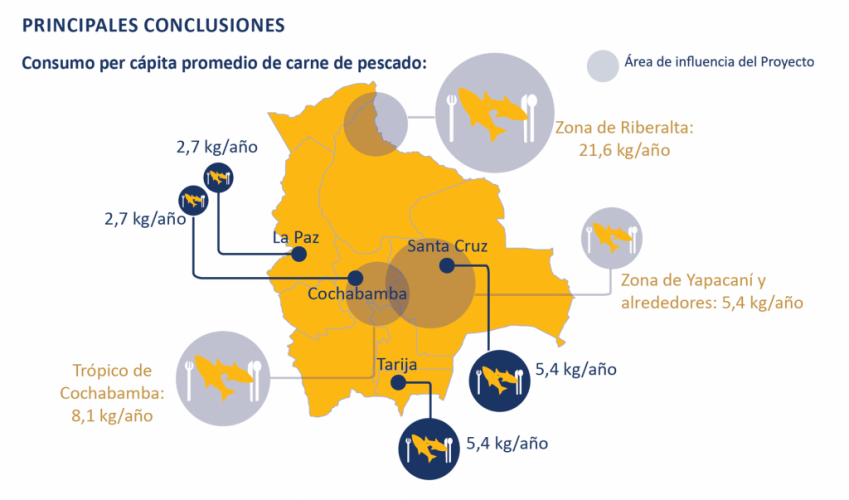The PPV II team, through IMG, successfully completed the national market investigation to find out the handling conditions, quality and consumption habits of fish in the metropolitan areas of La Paz, Cochabamba, Santa Cruz and Tarija, in addition to the area of influence of the Project (Riberalta municipality in Beni, San Juan, San Carlos and Yapacaní municipalities in Santa Cruz, and Entre Ríos and Puerto Villarroel municipalities in Cochabamba).
The PPV II team, through IMG, successfully completed the national market investigation to find out the handling conditions, quality and consumption habits of fish in the metropolitan areas of La Paz, Cochabamba, Santa Cruz and Tarija, in addition to the area of influence of the Project (Riberalta municipality in Beni, San Juan, San Carlos and Yapacaní municipalities in Santa Cruz, and Entre Ríos and Puerto Villarroel municipalities in Cochabamba).
According to the Director of IMG, "the research makes it possible to identify and characterize the demand for fish and consumption habits at the national level and obtain inputs to apply tools/means to improve access to marketing channels and access to new/better markets for fishing and fish farming sectors.
The study focused on six units of observation:
1. Retailers (points of sale to the public)
2. Final consumers
3. Producers of farmed pacú/tambaqui and paiche fishermen
4. Restaurants
5. Wholesalers
6. Supermarkets

The current demand for fish meat represents only 37.6% of the potential demand. This data gives a potential margin for market growth of more than 60%.
Given the option of increasing the consumption of fish meat, the number of times that the population would increase consumption was established, in addition to establishing the statistical probability that this would actually happen. From the analysis carried out, it can be inferred that, with an adequate supply of fish in quality and quantity, the population would consume 2.66 times more fish than it currently consumes.

75.4% of people consume fish at home and only 24.3% do so outside the home. There are differences at the level of the cities and areas of influence of the Project.
81.6% of the people surveyed indicate that the quality of the sales position is regular or bad.
The main factors identified that affect the decision to buy fish are: freshness of fish meat, 45.1%; price, 11.4%; presence of reddish gills, 10.4%; and appearance and color of the meat, 9.7%.
64.9% of people indicate that the price of fish in general is high.
Consumer profile
The identification and characterization of the consumer profile establishes that the potential market for cultivated pacú/tambaqui is made up of middle-class families with incomes of up to Bs. 3,900. In the case of paiche, the target market would rather include families of upper-middle class and with income above Bs. 3,900.
Contacts:
Luis Enrique Badani, IMG, lebadani@gmail.com
Alvaro Céspedes, IMG, lorcespedes@gmail.com

